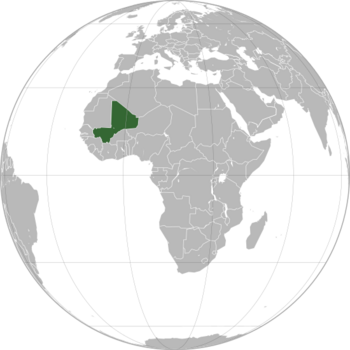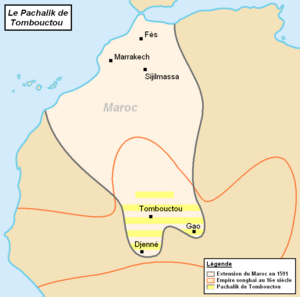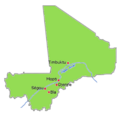History of Mali facts for kids
Mali is a country in Africa with a long and interesting history. Its borders today were set in 1891 by the French. These borders bring together different groups of people, making Mali a country with many cultures, though most people are from the Mandé peoples.
A big part of Mali's history is its role in trade across the Sahara Desert. This trade connected West Africa with North Africa. The city of Timbuktu is a great example of this. It's located on the edge of the Sahara, near the Niger River, and became a very important trading hub from the 13th century onwards, especially with the rise of the Mali Empire.
Contents
Ancient Times: Prehistory in Mali
Early Humans in the Sahara
Long ago, the Sahara Desert was not always as dry as it is today. It had periods when it was much wetter and greener. During these green times, people could live there. For example, between 125,000 and 110,000 years ago, there were many waterways. This allowed animals and human hunters to move north. Huge lakes, like the Mega Lake Chad, covered vast areas.
In Mali, we know that hunters and gatherers lived there over 150,000 years ago. Evidence found at the Ounjougou complex shows this. The time when early humans lived here ended around 25,000 to 20,000 years ago because the climate became very dry.
The New Stone Age: Farming and Pottery
After the last ice age, the climate became much wetter again. The Niger River formed a huge inland lake near Timbuktu. This wet period, which started around 9500 BC, slowly became drier after 5000 BC.
The New Stone Age, or Neolithic period, is when people started growing their own food instead of just hunting and gathering. This time is divided into three parts, separated by dry periods. People began planting sorghum and millet. Around 8000 BC, large herds of cattle grazed in what is now the Sahara. Sheep and goats came later from West Asia, but cattle were first tamed in Africa.
The earliest pottery in Mali was found at Ounjougou, dating back to about 9400 BC. This shows that people in Mali might have invented pottery on their own.
Later, around 4000 BC, nomadic cattle herders appeared. The climate became drier around 3500 BC. This dryness caused people to move south. Evidence from places like Karkarichinkat shows that people kept sheep, cattle, and goats. They also continued to hunt, gather, and fish.
Around 2500 BC, more people moved into Mali from the Sahara, which was becoming a huge desert. This dryness continued, forcing more people to move south. By the second half of the 2nd millennium BC, millet farming reached the region. This early farming ended around 400 BC due to another extreme drought.
People in ancient Mali also used red ochre in burials, even for animals. Rock carvings and paintings can be found across the Sahara, showing animals, symbols, and people.
Ancient Dental Practices
At sites in the Tilemsi Valley, north of Gao, scientists found that women around 4500-4200 years ago had their teeth changed for ritual reasons. This included removing or filing teeth to make them pointed. This custom continued until the 19th century.
People in this valley also got most of their food from grass seeds, showing early farming and cattle raising in West Africa around 2200 years ago.
Early Iron Age: First Cities
The first cities and towns in Mali were built by Mandé peoples, like the Soninke people, along the middle Niger River. One of these was Dia, Mali, which started around 900 BC. Another important city was Djenné-Djenno, which was lived in from about 250 BC to 800 AD. Djenné-Djenno was a large urban area with many mounds.
This city was very big and traded locally and with faraway places. During its second phase, it grew even larger and people started building permanent mud brick homes, including a city wall. This wall was about 3.7 meters wide at its base and ran almost two kilometers around the town.
Early Islamic writings also mention Mali, referring to places like "Pene" and "Malal." They also tell the story of an early ruler named Barmandana who converted to Islam.
Ghana Empire
The Ghana Empire was an important empire in West Africa before the Mali Empire.
Mali Empire: A Golden Age
The Mali Empire began in 1230 and became the largest empire in West Africa. It greatly influenced the culture of the region by spreading its language, laws, and customs.
The city of Timbuktu remained important as a trading center and a hub for the trans-Saharan slave trade until the 19th century. The empire was founded by Sundiata Keita and became famous for the great wealth of its rulers, especially Mansa Musa I. The Mali Empire had a huge impact on West Africa, spreading its culture along the Niger River. It covered a large area and included many smaller kingdoms and provinces.
The empire was known for its rich gold resources, which helped build amazing structures like the famous Great Mosque of Djenné. Mali also had a busy trade network that reached across the Sahara Desert to North Africa and the Middle East.
The Mali Empire included parts of modern-day Mali, Senegal, Gambia, Guinea, Mauritania, and parts of Niger and Burkina Faso. Mali itself was at the heart of this powerful empire.
Songhai Empire: Rise and Fall
The Mali Empire started to get weaker by the mid-14th century. The Songhai people saw this as a chance to become independent. They made Gao their capital and began to expand their own empire across the western Sahel. By 1420, the Songhai were strong enough to demand payments from Masina. The growing Songhai Empire and the weakening Mali Empire existed at the same time for much of the late 14th and 15th centuries. In the late 15th century, the Songhai Empire took control of Timbuktu.
After the Empires (1591–1892)
The Songhai Empire eventually fell apart due to pressure from the Moroccan Saadi dynasty. A key moment was the Battle of Tondibi on March 13, 1591. Morocco then controlled Gao, Timbuktu, Djenné, and the trade routes, but they found it very hard to keep control until the late 17th century.
After the Songhai Empire collapsed, no single state ruled the entire region. The Moroccans only managed to control small parts, and even there, their power was weak. Several smaller kingdoms rose up in what is now Mali:
Bambara Empire (Kingdom of Segou)
The Bambara Empire was a strong state from 1712 to 1861. Its main cities were Ségou and Timbuktu. It ruled parts of central and southern Mali. This empire lasted until El Hadj Umar Tall, a conqueror from the Toucouleur people, swept across West Africa. Umar Tall's army easily defeated the Bambara, taking Ségou on March 10, 1861, and ending the empire.
Kingdom of Kaarta
A split in the ruling family of Ségou led to the creation of a second Bambara state, the kingdom of Kaarta, in western Mali in 1753. It was defeated in 1854 by Umar Tall, the leader of the Toucouleur Empire, before his war with Ségou.
Kenedougou Kingdom
The Senufo Kenedugu Kingdom started in the 17th century near the border of Mali and Burkina Faso. In 1876, its capital moved to Sikasso. It fought off Samori Ture's attempts to conquer it in 1887 and was one of the last kingdoms in the area to fall to the French in 1898.
Maasina Empire
An Islamic uprising in the Inner Niger Delta region, mainly by the Fula people, led to the creation of a separate state in 1818. This state later joined the Bambara Empire against Umar Tall's Toucouleur Empire and was also defeated by him in 1862.
Toucouleur Empire
This empire was founded by El Hadj Umar Tall of the Toucouleur peoples. Starting in 1864, it eventually ruled most of what is now Mali until the French took over the region in 1890. This was a challenging time, with ongoing resistance and increasing pressure from the French.
Wassoulou Empire
The Wassoulou Empire was a short-lived empire (1878–1898) led by Samori Ture. It was located in the Malinké area of what is now upper Guinea and southwestern Mali. It later moved to Ivory Coast before being conquered by the French.
French Sudan (1892–1960)
Mali came under French colonial rule in 1892. By 1893, the French had a civilian governor for the territory they called Soudan Français (French Sudan). However, people continued to resist French rule. By 1905, most of the area was firmly under French control.
French Sudan was part of the Federation of French West Africa. It provided workers for France's coastal colonies in West Africa. In 1958, the Sudanese Republic gained full self-rule and joined the French Community. In early 1959, the Sudanese Republic and Senegal formed the Federation of Mali. On March 31, 1960, France agreed to the Federation of Mali becoming fully independent. On June 20, 1960, the Federation of Mali became an independent country, and Modibo Keïta became its first President.
Independence (1960–present)
Quick facts for kids
Republic of Mali
République du Mali (French)
|
|||||||||||
|---|---|---|---|---|---|---|---|---|---|---|---|
| 1960–1968 | |||||||||||
|
|
|||||||||||
|
Motto: "Un peuple, un but, une foi" (French)
"One people, one goal, one faith" |
|||||||||||
|
Anthem: "Le Mali" (French)
|
|||||||||||
 |
|||||||||||
| Capital | Bamako | ||||||||||
| Government | Unitary one-party socialist republic | ||||||||||
| President | |||||||||||
|
• 1960-1968
|
Modibo Keita | ||||||||||
| Prime minister | |||||||||||
|
• 1960-1965
|
Modibo Keita | ||||||||||
| Vice President | |||||||||||
|
• 1968-1971
|
Yoro Diakité | ||||||||||
|
• 1968-1979
|
Amadou Baba Diarra | ||||||||||
| Legislature | National Assembly | ||||||||||
| Historical era | Decolonisation of Africa, Cold War | ||||||||||
|
• Independence from France
|
20 June 1960 | ||||||||||
|
• Established one-party state
|
1960 | ||||||||||
|
• Tuareg rebellion
|
1962-1964 | ||||||||||
|
• 1968 Malian coup d'état
|
19 November 1968 | ||||||||||
| Currency | West African CFA franc (XOF) | ||||||||||
| ISO 3166 code | ML | ||||||||||
|
|||||||||||
After Senegal left the federation in August 1960, the former Sudanese Republic became the Republic of Mali on September 22, 1960. Modibo Keïta became its first president.
President Modibo Keïta quickly made Mali a one-party state and followed socialist policies, meaning the government took control of many businesses. Keïta also had close ties with Eastern European countries. However, Mali's economy got worse, so in 1967, they decided to rejoin the Franc Zone (a currency union with France) and change some of their economic policies.
From 1962 to 1964, there was a Tuareg uprising in northern Mali.
Under Moussa Traoré
|
Republic of Mali
République du Mali (French)
|
|
|---|---|
| 1968–1991 | |
|
|
|
 |
|
| Capital | Bamako |
| Government | One-party military dictatorship |
| Head of State | |
|
• 1968-1991
|
Moussa Traoré |
| Vice President | |
|
• 1968-1971
|
Yoro Diakité |
|
• 1968-1979
|
Amadou Baba Diarra |
| History | |
|
• Established
|
19 November 1968 |
|
• Disestablished
|
26 March 1991 |
| ISO 3166 code | ML |
| Today part of | Mali |
On November 19, 1968, a group of young military officers took control in a peaceful takeover. They formed a Military Committee for National Liberation (CMLN), with Lt. Moussa Traoré as president. The military leaders tried to improve the economy, but they faced internal political problems and a terrible drought in the Sahel region.
A new constitution was approved in 1974, creating a one-party state and aiming for civilian rule. However, the military leaders stayed in power. In September 1976, a new political party, the Democratic Union of the Malian People (UDPM), was formed. In June 1979, Moussa Traoré was elected president with almost all the votes in a one-party election. His efforts to strengthen the one-party government were challenged in 1980 by student protests, which led to three attempts to overthrow the government. These attempts were strongly stopped.
The political situation became more stable in the early 1980s. In late December 1985, a short war broke out between Mali and Burkina Faso over a border area rich in minerals.
The government then focused on Mali's economic problems. They approved plans to reform state-owned businesses and tried to control corruption. They also worked with the International Monetary Fund (IMF) on economic adjustments. But people became unhappy with the strict measures of the IMF plan, especially because they felt the ruling leaders were not following the same rules. As demands for multi-party democracy grew across Africa, the Traoré government allowed some limited political changes. However, they refused to create a full democratic system.
By 1990, new opposition groups started to appear. The political situation became more difficult with ethnic violence in the north in mid-1990. Many Tuareg people who had moved to Algeria and Libya during the long drought returned to Mali, increasing tensions between the nomadic Tuareg and the people who lived in settled communities. Fearing a Tuareg movement to break away, the Traoré government declared a state of emergency and strongly stopped the Tuareg unrest. Even after a peace agreement was signed in January 1991, unrest and armed clashes continued.
The 2000s: A New Era
President Konaré stepped down after serving his two allowed terms and did not run in the 2002 elections. Touré, who had been a military leader, then ran as a civilian. He won the presidency, promising national unity. The 2002 election was a big step for Mali, marking its first successful transfer of power from one democratically elected president to another. Touré then formed a government that included different political groups and promised to work on Mali's important social and economic problems.
The 2010s: Challenges and Changes
In January 2012, the National Movement for the Liberation of Azawad (MNLA) started an uprising. On March 22, 2012, rebel soldiers appeared on state TV, announcing they had taken control of the country. They said they were unhappy with how the president was handling the conflict with the rebels. The former president had to go into hiding.
However, because of the 2012 insurgency in northern Mali, the military government only controlled the southern part of the country. The northern part, known as Azawad, was controlled by MNLA rebels. The rebels took Timbuktu, which is 700 km from the capital. In response, the Economic Community of West African States (ECOWAS) froze assets and placed an embargo, leaving Mali with very little fuel. Mali relies on fuel brought by trucks from Senegal and Ivory Coast.
By July 2012, the Tuareg rebels were pushed out by their allies, the Islamists, Ansar Dine, and Al Qaeda in the Islamic Maghreb (A.Q.I.M.). This led to an extremist mini-state in northern Mali.
Refugees described the Islamists as wanting to force a strict form of Islam on Malian Muslims. In Timbuktu, the Islamists destroyed several old tombs of holy men, saying they were against their beliefs.
On December 10, 2012, Prime Minister Cheick Modibo Diarra was arrested by soldiers. Hours later, he announced his resignation on national television.
On January 10, 2013, Islamist forces captured the important town of Konna, 600 km from the capital. The next day, the French military launched Opération Serval, stepping in to help.
By February 8, the Malian military, with international help, had retaken the territory held by Islamists. Tuareg separatists also continued to fight the Islamists.
A peace deal between the government and Tuareg rebels was signed on June 18, 2013.
Presidential elections were held in Mali on July 28, 2013. Ibrahim Boubacar Keïta won and became the new President of Mali.
The peace deal between the Tuareg rebels and the Malian government broke down in late November 2013 due to clashes in the northern city of Kidal. A new ceasefire was agreed upon on February 20, 2015.
In August 2018, President Ibrahim Boubacar Keita was re-elected for another five-year term.
The 2020s: Recent Events
Starting June 5, 2020, street protests began in Bamako, calling for President Ibrahim Boubacar Keïta to resign. On August 18, 2020, mutinying soldiers arrested President Ibrahim Boubacar Keïta and Prime Minister Boubou Cissé. President Keïta resigned and left the country. The National Committee for the Salvation of the People, led by Colonel Assimi Goïta, took power. This was the fourth time the government was overthrown since Mali's independence in 1960. On September 12, 2020, the National Committee agreed to an 18-month transition to civilian rule. Soon after, Bah N'Daw was named interim president.
On May 25, 2021, Colonel Assimi Goïta removed the transitional president Bah N'Daw and the transitional prime minister Moctar Ouane from their positions. On June 7, 2021, Mali's military commander Assimi Goita was sworn in as the new interim president. France had withdrawn its troops from Mali in February 2022.
In 2023, Burkina Faso suggested forming a federation with Mali. The goal was to increase the political and economic power of both nations by combining their resources and populations. This idea was part of a larger trend of African countries forming regional alliances. However, the proposal faced some concerns due to cultural, historical, and economic differences, as well as questions about power sharing and losing national independence.
Images for kids
See also
 In Spanish: Historia de Mali para niños
In Spanish: Historia de Mali para niños
- Bamako history and timeline
- History of Africa
- History of West Africa
- List of heads of government of Mali
- List of heads of state of Mali
- Politics of Mali
- History of Timbuktu
- Mali National Archives
- Timeline of Mali






